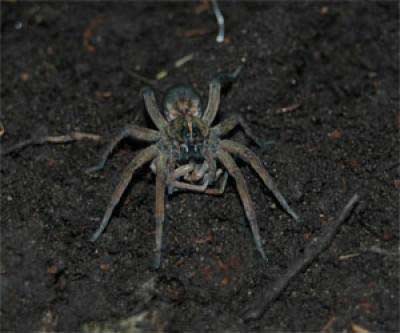Very Strange: The Spider Sex Chronicles

Spiders are bizarre sex freaks. But it’s all harmless fun … no wait, actually it’s very harmful. Girl kills guy or guy kills girl — there’s shrill crying, plugged orifices, torn-off genitals, eaten body parts, and psychedelic rituals. And you thought humans had crazy sex lives? Mounting evidence in recent years shows just how crazy spider sex is. Crazy courtship For example, in the case of redback spiders (Latrodectus hasselti), courtship tends to last an average of 50 minutes when males are competing head-to-head for mating rights and 4.5 hours for single, non-competing males. It seems as if the larger male redbacks would always be favored, but scientists recently discovered that the smaller ones actually get more action than their bigger counterparts because they mature faster and are quicker on their feet. Meanwhile, mature jumping spiders sport crucial glowing patches on their bodies to lure in mates, as if dressed for a rave. The males exhibit UV-reflecting scales that glow in bright white and green, and the females’ have front appendages that similarly glow in a bright green hue. Turns out, females and males will ignore each other if not seen under full-spectrum light, suggesting that both partners must show their glowing bodies to prove their health before courtship can proceed. Copulation and amputation Spiders reproduce sexually, however the male's sperm is not inserted into the female's body from within the male's genitals. Rather an intermediate stage takes place. Males ejaculate onto ready-made small sperm webs and then transfer their sperm to syringe-like structures on the tips of their front appendages, or palps. As courtship progresses for the male jumping spider, he will arch his body, vibrate his palps and slink on tiptoe toward the female. If courtship is successful, the male injects his sperm from his palps into the female’s genital opening, known as the epigyne, on the underside of her abdomen. In the Tidarren argo species, the male will amputate his own palp before he matures to improve his own mobility, only to have his remaining palp torn off by his mate, which stays attached to her epigyne for about four hours, independently transferring sperm into one of her seminal receptacles. Female spiders are able to store sperm from different males inside their bodies and can choose which male gets to fertilize her eggs. As a result, the males in two different spider species treat their respective female partners in completely different ways: A male orb-web (Argiope bruennichi) spider will actually break off the tip of his own genitals and leave his "manhood" in the female’s sexual orifice, effectively blocking future male’s efforts to inseminate the female. When her sex hole is blocked, copulation typically lasts for only eight seconds with subsequent males. Normally, male spiders copulate for twice as long, though redbacks can last as long as 31 minutes (and if that seems impressive, check out how a bite from the Brazilian wandering spider can stimulate an hours-long erection). The female Physoculus globusus spider even emits high-frequency squeaks to guide males while mating. Called stridulations, these shrill cries respond to the rhythmic squeezing actions of the male’s genitalia from inside the female during sex. The female squeaks to warn her mate if it squeezes too hard or too long — to which he’ll eagerly respond to raise his chances that his sperm will be selected. I'd love to have you for dinner! Once a session of quality lovemaking ends, the female of many species will often kill and eat the male after sex. Turns out it’s all about size: small male spiders are easier to catch as prey, and big females will eat their puny mates simply because they’re hungry. The size rule holds true in a wide range of spider species: among wolf spiders (Hogna helluo), small males were consumed 80 percent of the time by their female lovers. And in blood-drinking jumping spiders (Evarcha culicivora) of East Africa, it’s the males who are more cannibalistic than vice versa, especially to smaller females. Virgin female jumping spiders actually prefer to get deflowered by larger males, despite the cannibalistic risk. Once females lose their virginity, however, they change tack, fancying smaller, safer males to decrease their risk of getting eaten. Some female spiders will even eat their own offspring — perhaps for some energy benefit. Other mothers have an extremely touchy-feely side, such as Phyrynus marginemaculatus, a dime-sized, whip-spider species common in Florida. The arachnids constantly stay in tactile contact with each other by caressing their young and snuggling together, it was found.
- Gallery: Creepy Spiders
- Top 10 Swingers of the Animal Kingdom
- Bizarre: Spiders 'Fly' Hundreds of Miles
Get the world’s most fascinating discoveries delivered straight to your inbox.


